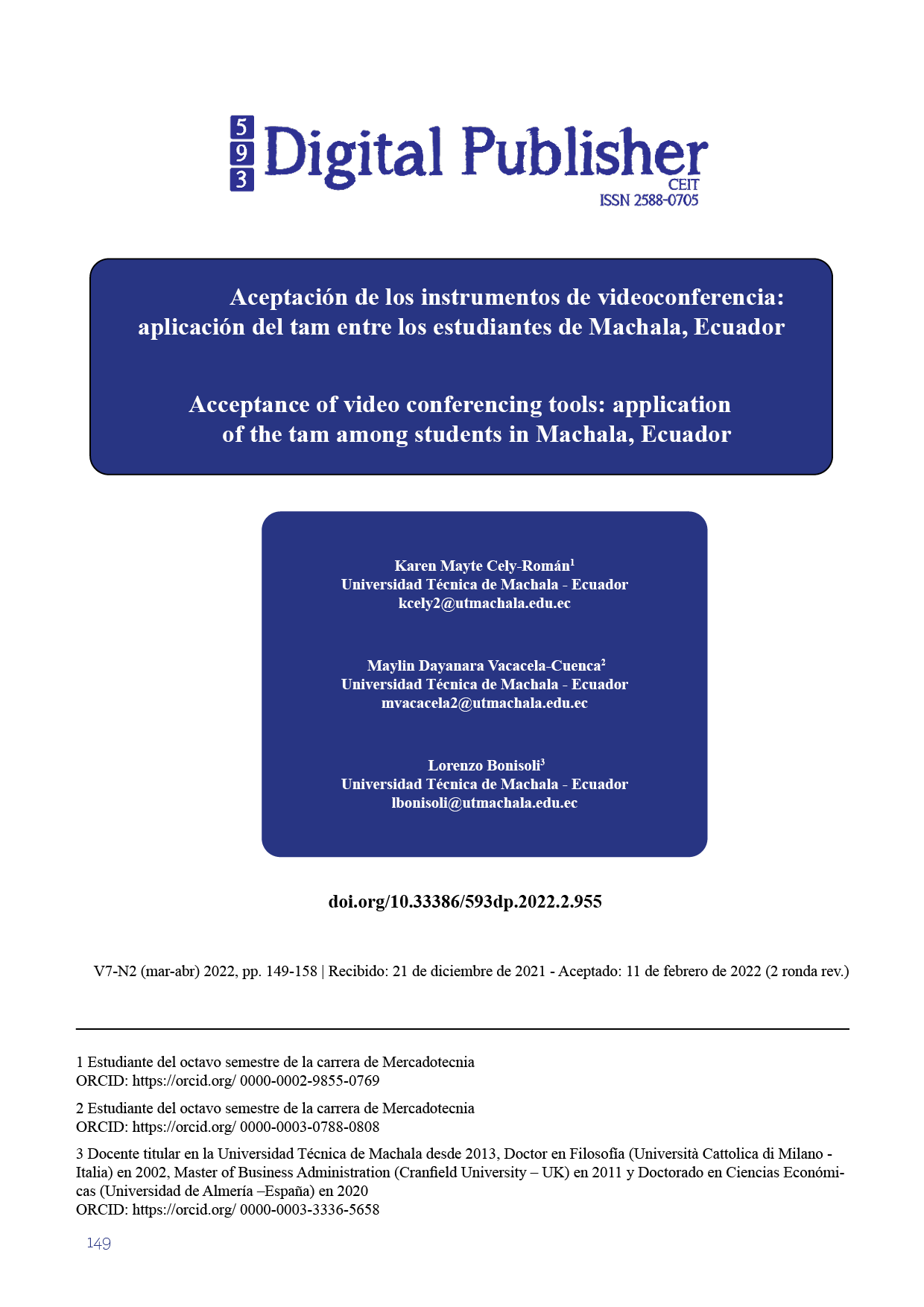Acceptance of video conferencing tools: application of the tam among students in Machala, Ecuador
Main Article Content
Abstract
Videoconferencing and the use of virtual presence applications have boomed worldwide during the COVID-19 pandemic. The restriction, which has been enacted in many countries, has forced educational institutions to adapt their teaching and learning processes to an online modality, increasing the use of videoconferencing applications such as Zoom, Google Meet and MS Teams. Although there are many studies on the effects of COVID-19 on daily life, there is no specific research on the acceptance of a virtual presence. This study examines the acceptance of videoconferencing applications among college students in marketing majors. A theoretical model based on TAM (Technology Acceptance Model) and analyzed using the SEMPLS technique is proposed. The results show that perceived usefulness, rather than ease of use, affects the intention to use videoconferencing applications.
Downloads
Article Details

This work is licensed under a Creative Commons Attribution-NonCommercial-ShareAlike 4.0 International License.
1. Derechos de autor
Las obras que se publican en 593 Digital Publisher CEIT están sujetas a los siguientes términos:
1.1. 593 Digital Publisher CEIT, conserva los derechos patrimoniales (copyright) de las obras publicadas, favorece y permite la reutilización de las mismas bajo la licencia Licencia Creative Commons 4.0 de Reconocimiento-NoComercial-CompartirIgual 4.0, por lo cual se pueden copiar, usar, difundir, transmitir y exponer públicamente, siempre que:
1.1.a. Se cite la autoría y fuente original de su publicación (revista, editorial, URL).
1.1.b. No se usen para fines comerciales u onerosos.
1.1.c. Se mencione la existencia y especificaciones de esta licencia de uso.
References
Bagozzi, R. P., & Yi, Y. (1988). On the evaluation of structural equation models. Journal of the Academy of Marketing Science, 16(1), 74-94. https://doi.org/10.1007/BF02723327
Cáceres, K. F. (2020). Educación virtual: Creando espacios afectivos, de convivencia y aprendizaje en tiempos de COVID-19. CienciAmérica, 9(2), 38-44. https://doi.org/10.33210/ca.v9i2.284
Chuttur, M. Y. (2009). Overview of the technology acceptance model: Origins, developments and future directions. Working Papers on Information Systems, 9(37), 9-37. http://adam.co/lab/pdf/test/pdfs/TAMReview.pdf
Davis, F. D. (1989). Perceived Usefulness, Perceived Ease of Use, and User Acceptance of Information Technology. The Mississippi quarterly, 13(3), 319-340. https://doi.org/10.2307/249008
Etikan, I., & Bala, K. (2017). Sampling and sampling methods. Biometrics & Biostatistics International Journal, 5(6), 62-65. https://doi.org/10.15406/bbij.2017.05.00149
Fornell, C., & Larcker, D. (1981). Evaluating Structural Equation Models with Unobservable Variables and Measurement Error. JMR, Journal of marketing research, 18, 39-50.
Gauthier, N. H., & Husain, M. I. (2021). Dynamic Security Analysis of Zoom, Google Meet and Microsoft Teams. Silicon Valley Cybersecurity Conference, 3-24. https://doi.org/10.1007/978-3-030-72725-3_1
Gefen, D., & Keil, M. (1998). The impact of developer responsiveness on perceptions of usefulness and ease of use: an extension of the technology acceptance model. SIGMIS Database, 29(2), 35-49. https://doi.org/10.1145/298752.298757
Hair, J. F., Hult, T. G., Ringle, C. M., & Sarstedt, M. (2021). A Primer on Partial Least Squares Structural Equation Modeling (PLS-SEM). SAGE.
Hardgrave, B., Davis, F., & Riemenschneider, C. (2014). Investigating determinants of software developers’ intentions to follow methodologies. Journal of management information systems : JMIS, 20(1), 123-151. https://doi.org/10.1080/07421222.2003.11045751
Haro, A. S., & Calderón, E. P. (2020). CARACTERIZACIÓN EPIDEMIOLÓGICA DE COVID-19 EN ECUADOR. InterAmerican Journal of Medicine and Health, 3, 1-7. https://doi.org/10.31005/iajmh.v3i0.99
Henseler, J., Ringle, C. M., & Sinkovics, R. R. (2009). The use of partial least squares path modeling in international marketing. En New Challenges to International Marketing (Vol. 39, p. 88). Emerald Group Publishing Limited. https://doi.org/10.1108/S1474-7979(2009)0000020014
Holden, H., & Rada, R. (2011). Understanding the Influence of Perceived Usability and Technology Self-Efficacy on Teachers’ Technology Acceptance. En Journal of Research on Technology in Education (Vol. 43, Número 4, pp. 343-367). https://doi.org/10.1080/15391523.2011.10782576
Holden, R. J., & Karsh, B.-T. (2010). The technology acceptance model: its past and its future in health care. Journal of Biomedical Informatics, 43(1), 159-172. https://doi.org/10.1016/j.jbi.2009.07.002
Hwangbo, Y., & Kim, S.-I. (2021). A study on video conferencing program user experience -Focused on Zoom and MS Teams-. Journal of Digital Convergence, 19(2), 339-344. https://doi.org/10.14400/JDC.2021.19.2.339
IBM Corp. (2017). IBM SPSS Statistics for Windows (Versión 25) [Windows].
Kock, N. (2015). Common method bias in PLS-SEM: A full collinearity assessment approach. International Journal of e-Collaboration, 11(4), 1-10. https://doi.org/10.4018/ijec.2015100101
Legris, P., Ingham, J., & Collerette, P. (2003). Why do people use information technology? A critical review of the technology acceptance model. Information & Management, 40(3), 191-204. https://doi.org/10.1016/S0378-7206(01)00143-4
Leturia, M. F., Mongelos, V. A., Gochicoa, A., & Cerda, F. (2021). Vista de Análisis de los aspectos jurídicos generales de las plataformas digitales de videoconferencias y, en particular, de ZOOM. Perspectivas, 3, 53-66. https://revistas.ucalp.edu.ar/index.php/Perspectivas/article/view/143/110
Mackinnon, D. P., Lockwood, C. M., & Williams, J. (2004). Confidence Limits for the Indirect Effect: Distribution of the Product and Resampling Methods. Multivariate Behavioral Research, 39(1), 99. https://doi.org/10.1207/s15327906mbr3901_4
Mesa Vieira, C., Franco, O. H., Gómez Restrepo, C., & Abel, T. (2020). COVID-19: The forgotten priorities of the pandemic. Maturitas, 136, 38-41. https://doi.org/10.1016/j.maturitas.2020.04.004
Moreno-Agudelo, J. A., & Valencia-Arias, A. (2017). Factores implicados en la adopción de software libre en las Pyme de Medellín (Factors Involved in the Adoption of Free Software by SMEs in Medellín). https://papers.ssrn.com/abstract=3519515
Nayir, E., Sezgi̇n, O., Altintaş, E., & Üçbi̇lek, E. (2012). Pratisyen hekimlerin hepatit B ve hepatit C hakkındaki bilgi düzeyleri. akademik gastroenteroloji dergisi, 11(2), 58-62. https://dergipark.org.tr/en/pub/agd/issue/1454/17522
Nikou, S. A. (2021). Web-based videoconferencing for teaching online : continuance intention to use in the post-COVID-19 period. Interaction Design and Architecture, 47(Winter), 21. https://strathprints.strath.ac.uk/76108/
Ringle, C. M., Wende, S., & Becker, J.-M. (2015). SmartPLS3 (Versión 3) [SmartPLS]. https://www.smartpls.com
Schleicher, A. (2020). The impact of Covid-19 on education - Insight from education at glance 2020. OECD. https://www.oecd.org/education/the-impact-of-covid-19-on-education-insights-education-at-a-glance-2020.pdf
Sharma, A., Tiwari, S., Kanti Deb, M., & Marty Jean, L. (2020). Severe acute respiratory syndrome coronavirus-2 (SARS-CoV-2): a global pandemic and treatment strategies. International journal of antimicrobial agents, 56(2), 106054. https://doi.org/10.1016/j.ijantimicag.2020.106054
Streukens, S., & Leroi-Werelds, S. (2016). Bootstrapping and PLS-SEM: A step-by-step guide to get more out of your bootstrap results. European Management Journal, 34(6), 618-632. https://doi.org/10.1016/j.emj.2016.06.003
Taber, K. S. (2018). The Use of Cronbach’s Alpha When Developing and Reporting Research Instruments in Science Education. Research in Science Education, 48(6), 1273-1296. https://doi.org/10.1007/s11165-016-9602-2
Williams, J., & Mackinnon, D. P. (2008). Resampling and Distribution of the Product Methods for Testing Indirect Effects in Complex Models. Structural Equation Modeling: A Multidisciplinary Journal, 15(1), 23-51. https://doi.org/10.1080/10705510701758166
Xayrullaevna, S. N., Pakhritdinovna, K. D., & Anvarovna, B. G. (2020). Digitalization of the economy during a pandemic: accelerating the pace of development. JCR, 7(15), 2491-2498. http://www.jcreview.com/fulltext/197-1594800213.pdf
Zhao, X., Lynch, J. G., & Chen, Q. (2010). Reconsidering Baron and Kenny: Myths and Truths about Mediation Analysis. The Journal of Consumer Research, 37(2), 197-206. https://doi.org/10.1086/651257




